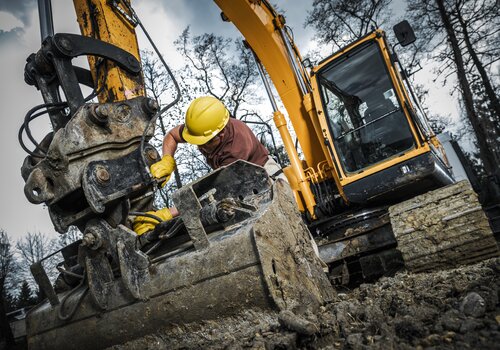As construction companies struggle with finding skilled labor, military veterans are a segment of the labor force that deserves attention. Vets currently make up about 5.3% of the construction workforce and each year approximately 200,000 vets transition out of the military. Those construction firms that have been successful in recruiting and retaining veterans say attributes such as leadership, reliability and accountability, attention to detail, adaptability and team focus, make them great hires. In addition, several programs are in place that makes it advantageous and cost-effective to train and hire vets. Here we share the key traits vets offer, how to recruit, and how to help vets transition from military to civilian employment.
4 Traits that Make Veterans a Great Hire
1. They understand accountability and teamwork. “Military training helps people develop a focus on reliability and self-accountability,” says Kim Garn, Craftforce Development Executive at Messer Construction Co., an employee-owned commercial construction contractor with 12 offices throughout the Midwest and Southeast. “Veterans are also team-performance focused.”
“Our veterans tell us that Messer is very close to the military in the way it provides processes to perform work and expectations for providing a safe environment,” adds Garn. “Even though we are a large company, we also like to have the connected feeling that you get being part of a small unit.”
2. “They’re adept at skill transfer.Military personnel are often trained in one area and moved to another. They have to quickly embrace change, train, learn and adapt. At the same time, they learn how to leverage their existing training, skills and knowledge in new roles.
“Construction also has various pathways that allow you to continue to learn and progress,” says Zoe Ridenour, Human Resources Manager for Kwest Group, an employee-owned civil construction contractor and environmental services firm. “The pathways laid out for construction inherently go hand-in-hand with how a veteran is used to progressing in the military,”
“For example, someone who starts as a laborer can go into heavy equipment operation or concrete finishing, then move up to a foreman, then superintendent,” she says.
3. They’re comfortable in discontinuous environments. “A military member could be sitting in an office one day, and the next day they could be deployed to a disaster area or war zone, “says Julie Davis, Vice President of People Strategy for the Association of Equipment Manufacturers (AEM). “This translates well to the construction industry where employees move from project to project as needed.”
4. They receive advanced technical training. “The military is always on the leading edge of technology,” says Davis. “Military veterans have been conditioned to be very technology-minded, always thinking about how innovation could advance their mission.”
How to Recruit Vets to Construction
The construction industry has a lot to offer vets. Being part of building roads, bridges and buildings can provide a great sense of satisfaction and purpose.Dedicating a section of your website to veterans makes it known that vets are welcome. Messer’s veteran web page provides information about a two-year laborer apprenticeship program and a four-year carpentry program. Kwest Group’s website highlights the company’s focus on prioritizing veterans and reserve service members and includes recognitions from hirevets.gov and the state of Ohio as a Veteran-friendly business enterprise.
“Having your current veterans share their experience is a great way to build interest,” says Ridenour. “Then word-of-mouth will help those recruiting efforts take off.” Messer also relies on testimonials from current veteran employees.
Kwest Group is in the midst of finalizing a program to assist veterans and non-traditional students to either explore their skills with our heavy equipment apprenticeship program or go to school to start towards a career in construction project management. “Not only will the veterans have a company point of contact for all their job specific needs, but they will be able to rely on others in the program and other veteran team members to help them throughout their new chapter,” says Ridenour.
Messer connects with veterans through community partnerships with organizations such as Easterseals, DOD Skill Bridge and Veterans Bridge Home as well as job fairs. According to Garn, the company looks beyond roles that easily translate to construction such as equipment operator or maintenance technician. “We are open to discussing opportunities with any veteran to see if we have the ability to get them in the door depending on their interest and background,” says Garn.
It’s important to understand a military resume to learn how skills can transfer. At Kwest, if an HR team member is unfamiliar with the specifics of a role a veteran has held, they collaborate with veteran employees to get an understanding before reaching out to the candidate. The following resources can help you get a better understanding of the military resume, including:
- A brief introduction to military workplace culture
- An explanation of common military terms
- Difference between the military branches
- An explanation of officer and enlisted ranks
- Civilian to Military Occupation Translator
Where to post your construction jobs to attract vets
These websites focus specifically on jobs for vets:
- GI Jobs is a commercial base job board that advertises heavily in the military community (Stars and Stripes newspaper, Military Times, etc.).
- Helmets to Hardhats is a national, nonprofit program that connects transitioning active-duty military service members, veterans, National Guard and Reservists with skilled training and quality career opportunities in the construction industry.
- HireMilitary Jobs is a subscription-based jobs board that allows direct connection with candidates. Candidates are eligible from 90 days prior to separation through 90 days following separation.
- Hire Heroes USA is a nonprofit that provides free job search support to U.S. military members, veterans and military spouses.
- Army Pays The Partnership for Your Success (PaYS) Program is a strategic partnership between the U.S. Army and a cross section of corporations, companies, and public sector agencies. The Program provides soldiers with an opportunity to serve their country while they prepare for their future. PaYS Partners guarantee soldiers an interview and possible employment after the Army.
Easing the transition
For many veterans the transition from the very structured environment of the military to an unstructured civilian work environment can be difficult. Training is a big part of Messer’s efforts to retain workers of all backgrounds. Veterans receive the same robust education and training available to all employees. “We have mentoring and coaching programs for all new hires,” says Garn.
Similarly, Kwest’s training programs embrace all team members. “Ensuring employees have the ability to build their own career path and have their leadership buy-in is essential to job satisfaction and retention” adds Ridenour.
Take advantage of incentive programs
Hiring vets has an added bonus because there are incentives and programs to support employers. The Workforce Innovation and Opportunity Act (WIOA) provides incentives for training and wage reimbursement.
The Work Opportunity Tax Credit (WOTC) incentivizes employers to hire “underutilized” workers, including veterans. In most cases, WOTC equals 40% of up to $6,000 in wages a qualifying employee earns during their first year. This means the maximum tax credit is usually $2,400. “Like most tools built into the tax code, it takes some knowledge to properly navigate WOTC,” says Davis.
Veteran Tax Credits (VTC) is an organization that helps veterans get approved for WOTC. VTC also assists employers in understanding how to utilize the WOTC program.
An employer also has the ability to bring on a veteran as an apprentice, paid for by the Department of Veterans Affairs (VA), if approved by the GI Bill. The Post 9/11 GI Bill offers veterans entry-level wages and a monthly housing allowance.
Under the DOD Skill Bridge Program, an employer can train vets to work on a temporary basis for up to six months — and it doesn’t cost a dime because the Department of Defense foots the entire bill.
VA Special Employer Incentive Program provides reimbursements for portions of veteran salaries. Vets in this program participate in the Vocational Rehabilitation and Employment (VR&E) program for vets with service-connected disabilities or employment handicaps.
Options for smaller firms
Smaller construction firms who may not have formal training programs can work with organizations that provide construction trades training for service members while they are still in the service, including Home Builders Institute (HBI). For veterans who have completed their service, there are groups like Adaptive Construction Solutions, The Warrior Alliance and Helmets to Hardhats.
For example, vets can participate in the certified training and apprenticeship program for construction equipment operators run through the International Union of Operating Engineers.
With construction firms increasingly short on labor, it’s time to stop searching for candidates that have every skill on your list and instead look at training candidates who already possess the soft skills you are looking for. Hiring a hero is a win-win for everyone.
Read Next
High School Teacher Prepares Students for Futures in Construction
Tips to Retain Good Workers: Lay the Groundwork for Honest Employee Feedback












